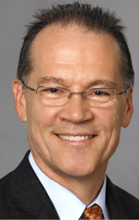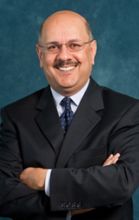IEEE GLOBECOM 2011 Keynote Talks
8:30-9:30, Tuesday, December 6, 2011
Room: GRB General Assembly A/B/C
Chair: Lee Gaspard, Shell, USA
Mr. John Donovan
Chief Technology Officer, AT&T
(Session Chair: Lee Gaspard, Shell, USA)
"Mobile Innovation: Advancing the Mobile Broadband Experience"

Abstract:
The future of communications will be driven by mobility, and specifically innovations on three fronts: Network and Cloud, Integrated Software and Devices and User Interfaces. The cumulative experience of advances in these areas will weave mobile communications even more tightly into the fabric of our global economy and our daily lives. John Donovan will show applications and devices that AT&T is working on today in its labs and innovation centers that illustrate the industry developments it’s helping to drive. He’ll close by sharing his vision for where these developments will take the enterprise and consumer mobile broadband experience in 2020 and beyond.
Bio:
Mr. Donovan is chief technology officer for AT&T. In this role, he oversees the company's global technology direction and innovation road map, including product development, network and engineering operations, AT&T Labs and the security and intellectual property organizations.
Mr. Donovan previously was executive vice president of product, sales, marketing and operations at Verisign Inc., a technology company that provides Internet infrastructure services. At VeriSign, Mr. Donovan was responsible for leading VeriSign’s global sales organization, driving the expansion of broad solutions offerings, and integrating a global professional services capability.
Before that, he was chairman and CEO of inCode Telecom Group Inc., where he helped shape strategic direction and positioning for wireless network operators around the globe. Previously, Mr. Donovan was a partner with Deloitte Consulting, where he was the Americas Industry Practice director for telecom. He is chairman of the board of the Alliance for Telecommunications Industry Solutions (ATIS).and is a director on the board of The Wholesale Applications Community (WAC).
He has authored two books, The Value Enterprise, published in January 1998, and Value Creating Growth, published in 1999. Donovan received a B.S.E.E. from the University of Notre Dame and earned an M.B.A. in finance from the University of Minnesota.
11:0-12:00, Wednesday, December 7, 2011
Room: GRB General Assembly A/B/C
Chair: Xi Zhang, Texas A&M University, USA
Dr. Laurence B. Milstein
Ericsson Chair Professor, University of California at San Diego
(Session Chair: Xi Zhang, Texas A&M University, USA)
"PHY-APP Cross-Layer Design for Mobile Video"

Abstract:
This talk will focus on cross-layer design for mobile video transmission, and is motivated by the tremendous demands that video users have placed on the capacity of wireless networks in recent years. The emphasis is on joint optimization of the physical and application layers for levels of mobility ranging from fixed wireless to vehicular speeds. The basic philosophy of the cross-layer design is first discussed, and then various examples are presented for both scalable and non-scalable video. These examples include the joint optimization of single-carrier MIMO systems in conjunction with motion-compensation techniques for scalable video, and OFDM-based video-slice to subcarrier-mapping techniques for non-scalable video. Metrics for evaluation of the usefulness of the cross-layer approach will include both the performance of individual users and the capacity gain of multiplexed users.
Bio:
Laurence B. Milstein (S66, M68, SM77, F85) received the B.E.E. degree from the City College of New York, New York, NY, in 1964, and the M.S. and Ph.D. degrees in electrical engineering from the Polytechnic Institute of Brooklyn, Brooklyn, NY, in 1966 and 1968, respectively.
From 1968 to 1974, he was with the Space and Communications Group of Hughes Aircraft Company, and from 1974 to 1976, he was a member of the Department of Electrical and Systems Engineering, Rensselaer Polytechnic Institute, Troy, NY. Since 1976, he has been with the Department of Electrical and Computer Engineering, University of California at San Diego, La Jolla, where he is the Ericsson Professor of Wireless Communications Access Techniques and former Department Chairman, working in the area of digital communication theory with special emphasis on spread-spectrum communication systems. He has also been a consultant to both government and industry in the areas of radar and communications.
Dr. Milstein was an Associate Editor for Communication Theory for the IEEE TRANSACTIONS ON COMMUNICATIONS, an Associate Editor for Book Reviews for the IEEE TRANSACTIONS ON INFORMATION THEORY, an Associate Technical Editor for the IEEE Communications Magazine, and the Editor-in-Chief of the IEEE JOURNAL ON SELECTED AREAS IN COMMUNICATIONS. He has been a member of the board of governors of both the IEEE Communications Society and the IEEE Information Theory Society, and was the Vice President for Technical Affairs in 1990 and 1991 of the IEEE Communications Society. He is also a former Chair of the IEEE Fellows Selection Committee, and is a recipient of the 1998 Military Communications Conference Long Term Technical Achievement Award, an Academic Senate 1999 UCSD Distinguished Teaching Award, an IEEE Third Millennium Medal in 2000, the 2000 IEEE Communication Society Armstrong Technical Achievement Award, and various prize paper awards.
10:30 – 11:15, Thursday, December 8, 2011
Room: GRB General Assembly A/B/C
Chair: Mahmoud Daneshmand, AT&T, USA
Dr. Farnam Jahanian
Assistant Director, CISE Directorate, NSF
(Session Chair: Mahmoud Daneshmand, AT&T, USA)
"Innovating for Society: Realizing the Promise of Computing and Communications"

Abstract:
The computing discipline is at the center of an ongoing societal transformation. The explosive growth of scientific and social data, wireless connectivity at broadband speeds for billions of mobile endpoints, and seamless access to computational resources in the “cloud” are transforming the way we work, learn, play, and communicate. Advances in computation and data-enabled techniques will continue to accelerate the pace of scientific discovery and engineering innovation, with the impact becoming more pervasive throughout society for decades to come.
We can envision a day where static infrastructure, such as buildings or factories, have been transformed into smart spaces that continuously adapt to consumption, growth, usage, and environmental stimuli through the use of networked instrumentation and distributed software control. We can imagine improved quality of life through personalized healthcare and assistive technologies, enabled in part by robust, usable, and trustworthy wearable mobile devices integrated with instrumented environments. We can anticipate that during a time of natural disaster or national emergency, unmanned search, rescue, and recovery will save lives and minimize loss through the use of autonomous, highly coordinated, and remotely operated robotic systems. By developing rich ecological and environmental distributed monitoring systems, we can create accurate models that support forecasting and management of increasingly stressed watersheds and ecosystems. These are just a few examples of advances that promise to reshape our world with more responsive, precise, and scalable systems to augment human capabilities, work in dangerous or inaccessible environments, provide large-scale and distributed coordination, and enhance societal well-being.
I will focus my talk on some of the technological and societal trends that are shaping our future and providing new opportunities for foundational research. I will further explore how these advances serve as key drivers of economic competitiveness and how they will be crucial to achieving national priorities in environmental sustainability, smart transportation, education and life-long learning, and national security.
Bio:
Farnam Jahanian leads the National Science Foundation Directorate for Computer and Information Science and Engineering (CISE). He is on leave from the University of Michigan, where he holds the Edward S. Davidson Collegiate Professorship and served as Chair for Computer Science and Engineering from 2007 – 2011 and as Director of the Software Systems Laboratory from 1997 – 2000. His research on Internet infrastructure security formed the basis for the Internet security company Arbor Networks, which he co-founded in 2001. He served as Chairman until its acquisition by Tektronix Communication in 2010.
Dr. Jahanian guides CISE, with a budget of over $600 million, in its mission to uphold the nation’s leadership in computer and information science and engineering through its support for fundamental and transformative advances. Dr. Jahanian is also co-chair of the Networking and Information Technology Research and Development (NITRD) Subcommittee of the National Science and Technology Council Committee on Technology, providing overall coordination for the activities of 14 government agencies.
Dr. Jahanian holds a master's degree and a Ph.D. in Computer Science from the University of Texas at Austin. He is a Fellow of the Association for Computing Machinery (ACM), the Institute of Electrical and Electronic Engineers (IEEE), and the American Association for the Advancement of Science (AAAS).